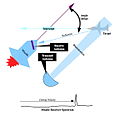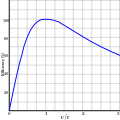Portal:Rocketry
The Rocketry Portal

A rocket (from Italian: rocchetto, lit. 'bobbin/spool') is a vehicle that uses jet propulsion to accelerate without using the surrounding air. A rocket engine produces thrust by reaction to exhaust expelled at high speed. Rocket engines work entirely from propellant carried within the vehicle; therefore a rocket can fly in the vacuum of space. Rockets work more efficiently in a vacuum and incur a loss of thrust due to the opposing pressure of the atmosphere.
Multistage rockets are capable of attaining escape velocity from Earth and therefore can achieve unlimited maximum altitude. Compared with airbreathing engines, rockets are lightweight and powerful and capable of generating large accelerations. To control their flight, rockets rely on momentum, airfoils, auxiliary reaction engines, gimballed thrust, momentum wheels, deflection of the exhaust stream, propellant flow, spin, or gravity.
Rockets for military and recreational uses date back to at least 13th-century China. Significant scientific, interplanetary and industrial use did not occur until the 20th century, when rocketry was the enabling technology for the Space Age, including setting foot on the Moon. Rockets are now used for fireworks, missiles and other weaponry, ejection seats, launch vehicles for artificial satellites, human spaceflight, and space exploration.
Chemical rockets are the most common type of high power rocket, typically creating a high speed exhaust by the combustion of fuel with an oxidizer. The stored propellant can be a simple pressurized gas or a single liquid fuel that disassociates in the presence of a catalyst (monopropellant), two liquids that spontaneously react on contact (hypergolic propellants), two liquids that must be ignited to react (like kerosene (RP1) and liquid oxygen, used in most liquid-propellant rockets), a solid combination of fuel with oxidizer (solid fuel), or solid fuel with liquid or gaseous oxidizer (hybrid propellant system). Chemical rockets store a large amount of energy in an easily released form, and can be very dangerous. However, careful design, testing, construction and use minimizes risks. (Full article...)
Selected article -
The Saunders-Roe SR.177 was a 1950s project to develop a combined jet- and rocket-powered interceptor aircraft for the Royal Air Force (RAF) and Royal Navy. It was an enlarged derivative of the Saunders-Roe SR.53, which was itself an experimental combined jet-and-rocket interceptor aircraft.
The SR.177 principally differed from the smaller SR.53 in its adoption of a nose-mounted airborne interception radar unit, which allowed it to scan for and lock onto its own targets; a more powerful turbojet engine was also incorporated. In addition to British interests in the aircraft, the German Navy had also expressed their interest in the project and closely evaluated its progress with an eye towards its potential procurement. However, the SR.177 was ultimately cancelled as a result of changes in Britain's military policies in 1957. (Full article...)In the news
- 19 May 2024 – Russian invasion of Ukraine
- At least six people are killed and 27 others are injured in a Russian double tap missile strike on a recreation area near Kharkiv. Separately, five people are killed and nine others are injured in a Russian strike using a multiple launch rocket system on two villages in Kupiansk Raion, Kharkiv Oblast. (Reuters)
- 10 May 2024 – M23 offensive
- The death toll from rocket strikes on an IDP camp in Goma, Democratic Republic of the Congo, increases to 35. (AP)
- 7 May 2024 – M23 offensive
- The death toll from rocket strikes on an IDP camp in Goma, Democratic Republic of the Congo, increases to 18. (Reuters)
- 5 May 2024 – Israel–Hamas war
- Israeli air raids in Meiss Ej Jabal, Lebanon, cause "massive destruction" according to a Lebanese state-run agency, killing four civilians and injuring three others. In response, Hezbollah fires dozens of Katyusha and Falaq rockets towards Kiryat Shmona, Israel. (Reuters)
- Three Israeli soldiers are killed and ten civilians are injured when Hamas launches a rocket barrage at the Kerem Shalom border crossing. (Times of Israel) (Reuters) (Jerusalem Post)
Topics
List articles
Things to do
 |
Here are some tasks awaiting attention:
|
Wikimedia
The following Wikimedia Foundation sister projects provide more on this subject:
-
Commons
Free media repository -
Wikibooks
Free textbooks and manuals -
Wikidata
Free knowledge base -
Wikinews
Free-content news -
Wikiquote
Collection of quotations -
Wikisource
Free-content library -
Wikispecies
Directory of species -
Wikiversity
Free learning tools -
Wikivoyage
Free travel guide -
Wiktionary
Dictionary and thesaurus




















































